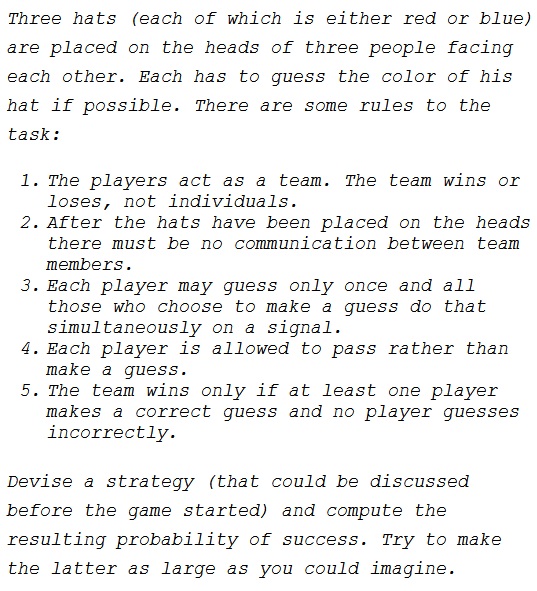Acting As a Team I
Problem

Strategy 1
Each player chooses the color randomly. The probability of success is $\displaystyle P=\left(\frac{1}{2}\right)^3=\frac{1}{8}.$
Strategy 2
There are eight possible combinations of hat colors. Each player has to choose between $R(ed),$ $B(lue),$ or $P(ass),$ making $27$ possible team answers. Each player makes a random choice, now between three possibilities.
If all pass, the team loses. With two passes, there are $6$ possible answers, each with probability of $\displaystyle \frac{1}{2}$ of a correct guess. With one pass, there are $12$ possible answers, each with probability of $\displaystyle \frac{1}{4}$ of a correct guess. With no passes, there are $8$ possible answers, each with probability of $\displaystyle \frac{1}{8}$ of being right. The total comes to
$\displaystyle\begin{align}P&=\frac{1}{27}\left(0\cdot 1+\frac{1}{2}\cdot 6+\frac{1}{4}\cdot 12+\frac{1}{8}\cdot 8\right)\\ &=\frac{3+3+1}{27}=\frac{7}{27}\gt \frac{7}{28}=\frac{1}{4}. \end{align}$
Strategy 3
Strategies 1 and 2 are stupid: the fewer people make a guess, the higher is the probability of success. However, in order to win at least one guess ought to be made. The probability of success is $\displaystyle \frac{1}{2}.$
Elwin Berlekamp's Strategy
- If you see two hats of the same color, guess the other color.
- If you see two hats of different colors, pass.
The results of the strategy are summarized in the table below:
$\begin{array}{ccccccccc} A&B&C&&A&B&C&&Outcome\\ \hline R&R&R&&GBW&GBW&GBW&&lose\\ R&R&B&&pass&pass&GBC&&win\\ R&B&R&&pass&GBC&pass&&win\\ R&B&B&&GRC&pass&pass&&win\\ B&R&R&&GRC&pass&pass&&win\\ B&R&B&&pass&GRC&pass&&win\\ B&B&R&&pass&pass&GRC&&win\\ B&B&B&&GRW&GRW&GRW&&lose \end{array}$
In the table, $GBW=guess\;blue:\;wrong,$ $GBC=guess\;blue:\;correct,$ $GRW=guess\;red:\;wrong,$ $GRC=guess\;red:\;correct.$ The strategy gives six team wins out of eight: $\displaystyle \frac{6}{8}=\frac{3}{4}.$
Acknowledgment
This is one of the problems from Chapter 6 of J. Havil's Impossible? Surprising Solutions to Counterintuitive Conundrums (Princeton University Press, 2008). Previously, the problem appeared in P. Winkler's Mathematical Puzzles: A Connoisseur's Collection (A K Peters, 2004)
|Contact| |Front page| |Contents| |Probability|
Copyright © 1996-2018 Alexander Bogomolny71548501
